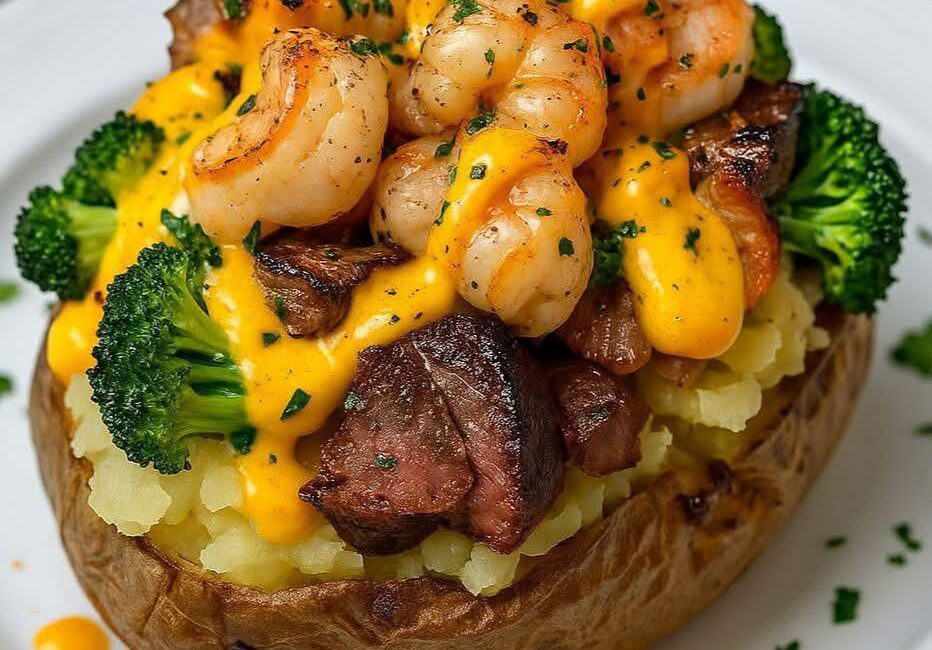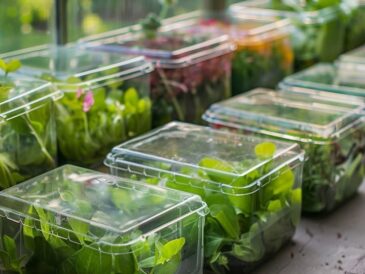Introduction: Why This Loaded Baked Potato Is a Game-Changer
Few dishes offer the warmth, richness, and satisfaction like a fully loaded baked potato. This isn’t just any baked potato — it’s a culinary symphony of tender steak bites, succulent shrimp, fresh steamed broccoli, and a luscious creamy cheddar sauce that ties everything together.
The loaded baked potato is one of those meals that fits every occasion — a cozy weeknight dinner, a special weekend indulgence, or a hearty option when feeding guests. It’s the perfect blend of flavors and textures: the crispy skin, fluffy potato interior, savory meat, sweet seafood, fresh greens, and melting cheese sauce.
In this ultimate guide, you’ll learn everything you need to know to master this dish: from selecting and preparing ingredients, cooking techniques, assembling the dish like a pro, to advanced tips and creative variations.
Section 1: Understanding the Core Ingredients — More Than Just Basics
Russet Potatoes: The Backbone of the Dish
The choice of potato is critical. Russets, with their high starch and low moisture content, are the classic baked potato choice because:
- Their thick skin crisps up beautifully, providing texture and flavor.
- The interior becomes light, fluffy, and airy, perfect for mashing and mixing with toppings.
- Russets absorb the flavors of toppings and sauces, making each bite rich and satisfying.
Fun fact: Russets originated in the United States in the late 19th century and are also known as Idaho potatoes. They are large and oval-shaped, perfect for baking.
The Steak — Protein with Character
Steak brings an earthy, umami-packed flavor that contrasts delightfully with the potato’s mildness.
- Cuts like sirloin, ribeye, or tenderloin offer tenderness and flavor without excess fat.
- The Maillard reaction (the browning of proteins during cooking) creates complex flavors and a crisp exterior on the steak cubes.
Shrimp: The Sweet & Briny Contrast
Shrimp adds a subtle sweetness and briny taste that enhances the umami profile of the steak.
- Shrimp are high in protein, low in calories, and rich in nutrients like selenium and vitamin B12.
- Properly cooked shrimp are juicy and tender, with a delicate snap in every bite.
Broccoli: The Green Crunch
Broccoli not only adds nutritional value but also balances the dish’s richness.
- Rich in vitamins C, K, and folate, broccoli also contains antioxidants that help combat inflammation.
- Steamed broccoli preserves nutrients and keeps a slight crunch, preventing the dish from becoming too heavy.
Cheddar Cheese & Heavy Cream: The Velvety Binder
Cheddar cheese melted into heavy cream forms the base of the creamy sauce that unifies every ingredient.
- Sharp cheddar introduces a slight tang and depth of flavor.
- Heavy cream ensures the sauce is smooth, rich, and luxurious.
Section 2: The Science of Perfectly Baked Potatoes
Baking a potato sounds simple, but there’s a science behind it:
- Pricking the potato: Fork holes allow steam to escape and prevent bursting.
- Oven temperature: Baking at 400°F (200°C) allows the starch inside to gelatinize and the skin to crisp.
- Time: 45-50 minutes ensures the inside is fluffy without drying out.
Pro tip: Wrapping potatoes in foil traps moisture and softens the skin. For crispier skin, bake without foil.
Section 3: Searing Steak — The Art of the Perfect Crust
Steak cubes must be seared over high heat quickly to develop the Maillard reaction, creating a crispy, flavorful crust while locking in juices.
- Use a heavy-bottomed skillet or cast iron for even heat distribution.
- Avoid overcrowding the pan to ensure proper searing, not steaming.
- Rest the steak after cooking so juices redistribute, ensuring tenderness.
Section 4: Cooking Shrimp — Timing is Everything
Shrimp cook rapidly and can become tough when overcooked.
- Watch for color changes: from translucent grey to opaque pink.
- Shrimp curls into a ‘C’ shape when done; overcooked shrimp form a tight ‘O’ shape, indicating toughness.
Section 5: Steaming Broccoli for Optimal Texture and Nutrition
- Use a steaming basket over boiling water to preserve vitamins.
- Steam for 3-5 minutes until broccoli is vibrant green and tender-crisp.
- Avoid overcooking to keep texture and color.
Section 6: Crafting the Creamy Cheddar Sauce
- Melt butter gently before adding cream to avoid burning.
- Slowly incorporate cheese off the heat to prevent grainy sauce.
- Season with salt, pepper, and optional garlic powder for extra depth.
Section 7: Step-By-Step Cooking Instructions
Ingredients (Serves 2)
- 2 large russet potatoes
- ½ lb steak, cubed
- 8 large shrimp, peeled and deveined
- 1 cup broccoli florets, steamed
- 1 cup shredded cheddar cheese
- ¼ cup heavy cream
- 1 tbsp butter
- 1 tbsp olive oil
- Salt & black pepper
- Fresh parsley, chopped
Method
- Bake Potatoes: Preheat oven to 400°F. Prick potatoes and bake 45-50 minutes.
- Sear Steak: Season steak with salt and pepper. Heat olive oil in skillet. Sear steak cubes 3-4 minutes. Remove and rest.
- Cook Shrimp: In same skillet, cook shrimp 1-2 minutes each side until pink. Remove.
- Steam Broccoli: Steam broccoli until tender-crisp.
- Make Sauce: Melt butter, add cream, simmer, then stir in cheddar off heat.
- Assemble: Cut potatoes open, fluff interiors. Top with steak, shrimp, broccoli, and drizzle sauce. Garnish with parsley.
Section 8: Presentation and Serving Suggestions
- Serve on a large plate or wooden board for rustic charm.
- Garnish with fresh parsley and lemon wedges.
- Accompany with a simple green salad or garlic bread.
Section 9: Nutritional Analysis and Health Benefits
- High protein for muscle repair (steak and shrimp).
- Vitamins and fiber from broccoli support digestion and immunity.
- Carbs from potato provide energy.
- Healthy fats from butter and cream aid nutrient absorption.
Section 10: Creative Variations to Try
- Use blue cheese instead of cheddar for pungency.
- Add sautéed mushrooms or caramelized onions.
- Swap shrimp for scallops or lobster for luxury.
- Make it spicy with jalapeños or chipotle sauce.
Section 11: FAQs
- Can I prepare this in advance? Yes, cook components separately and assemble before serving.
- Is there a vegetarian version? Yes, substitute steak and shrimp with grilled veggies and beans.
- How do I reheat without losing crispiness? Oven reheating preferred over microwave.
Section 12: Storing and Leftover Tips
- Store components separately in airtight containers up to 3 days.
- Reheat toppings and potato individually for best texture.
Section 13: Cultural and Culinary Context
Loaded baked potatoes have roots in American comfort food but are loved worldwide. This fusion with steak and seafood reflects surf-and-turf traditions—combining land and sea for maximum flavor.
Conclusion: Why This Recipe Will Become a Staple
This loaded baked potato is more than just a meal — it’s an experience. The contrasting flavors and textures offer comfort and indulgence, while the nutritional balance makes it a smart choice. With straightforward steps and room for customization, it’s a recipe you’ll return to again and again.
Ready to impress with this hearty, flavorful dish? Grab your ingredients and get cooking — your perfect loaded baked potato awaits!



